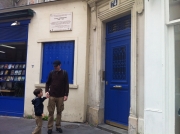
One of my treasured memories as a Hemingway scholar is from Ronda in 2006, when I spoke with René Villarreal about Hemingway’s ability to salsa dance. (Apparently he liked salsa music but shied away from dancing whenever possible.) This year I had an invitation to Paris for a workshop the first week in June and faced a problem: either return home after the event and fly back to France in July - or secure housing in Europe for seven weeks. As neither option was possible, I watched the Hemingway conference events online from Ecuador.
It’s clear that digital technologies are becoming an integral part of Hemingway Studies – and contemporary research has come to involve searching beyond traditional sources for interviews, video, quotes, and other scholarly content. The popularity of the Hemingway Society website and blog, as well as other Hemingway-related blogs, together with twitter, Facebook and YouTube, indicate that these online tools transcend social exchanges and are becoming an important method of disseminating scholarship and new material related to Hemingway.
The 18th International Hemingway Conference, “Hemingway in Paris,” 22-28 July 2018 was perhaps the most digitally-engaged society event to date. While I do not have a twitter account and do not use Facebook, digital participation wasn’t an obstacle. Many Facebook posts were open to the public and there’s a way to follow an event on twitter via hashtag without having a twitter account (this link opens the #EHParis18). The conference program was made available online several weeks before the event, and Thomas Bevilacqua’s daily blog updates kept my finger on the refresh button each afternoon.
The #EHParis18 hashtag received just under 200 tweets, some with videos, maps, pictures of social events and meals, and updated venue information. Some of the most active tweeters were Nissa Ren Cannon, who live-tweeted from panels; and the Hemingway Society handle, which posted daily material. I was intrigued by Amy Wells’s image of places mentioned in Spain in Death in the Afternoon and Wolfgang Stock’s paper on Hemingway in Peru, and contacted them via email. I reached out to about a dozen presenters altogether, all of whom sent me papers or summaries of their work, as well as some other interesting ideas and material. I was grateful for this distance-collaboration with, among others, Amy Wells, Steve Paul, Michael Von Cannon, Sue Barker, Gerry Kennedy, M. Denise Costello, Courtney Watson, John D. Schwetman, and Wolfgang Stock.
One of the papers that I particularly enjoyed was Sue Barker’s “The Importance of Being English: Ernest Hemingway’s British Heritage Reconsidered,” which has some information on the British colony in Oak Park in the late nineteenth-century and its influence on the Hemingway family holidays, meals, and language. “Grace [Hall] was undoubtedly a hyphenated American,” she writes.
Cheers to those at the American University of Paris who posted opening remarks and the Hemingway and the Movies panel on Facebook, and to Connie Chen, whose YouTube videos include Why I Love Hemingway and Song aboard the Bateau-Mouche led by H. R. Stoneback. (Chen’s videos from Oak Park in 2016 are also outstanding; they track conference events and have interviews with HR Stoneback, Tim O’Brien, and Valerie Hemingway. I sat forward in my chair when Chen asked Valerie Hemingway, “Did he ever pray with you?”)
Thinking of Hemingway in Paris, I wanted to re-listen to Hadley Richardson’s Paris interviews. That search brought me the sad news that Wendy Simpson (also known as Allie Baker) who managed The Hemingway Project, one of my favorite e-resources for things Hemingway, passed in 2016. Some of the links she posted are missing as well, including all of the audio of Hadley’s interviews. But with some additional searching, I found that a great deal of Simpson’s work is still available online via archive.org. I was able to find some of Hadley’s interviews as well, including her comments about the lost manuscripts, their divorce, and their first apartment. There are also discussions of red beans and beer, expatriate life in the raw, Horton Bay, and Pamplona. Though no longer listed on thehemingwayproject.com, Simpson’s insightful comments that accompanied the audio clips are available here and here.
I think the material available online—live broadcasts of panels and plenary speakers, tweets, Facebook posts and the like—brings more attention to the event and allows new forms of engagement. If there is a feasible way to allow responses and questions (via email, tweets or Facebook posts) during the live-broadcast panels, that could add another dimension to the conversation. (There were a few questions I had myself for the film panel that I watched live but didn’t have a way to send them.) It might be worthwhile to consider a digital grant for a society member to manage the online presence of the conferences and other events.
While conversing in Spanish about Hemingway’s dance moves with the Finca Vigía’s mayordomo can’t be recreated in any language, the digital footprints of Hemingway conferences can be excellent resources for future scholarship.